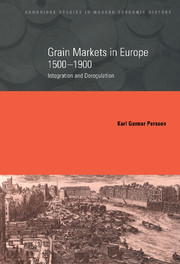Book contents
- Frontmatter
- Contents
- List of figures
- List of tables
- Preface
- Acknowledgements
- List of abbreviations
- 1 Bread and Enlightenment: the quest for price stability and free trade in eighteenth-century Europe
- 2 Markets, mortality and human capabilities
- 3 Harvest fluctuations, storage and grain-price responses
- 4 Market failures and the regulation of grain markets: a new interpretation
- 5 Market integration and the stabilisation of grain prices in Europe, 1500–1900
- 6 Authoritarian liberalism and the decline of grain market regulation in Europe, 1760–1860
- Sources
- Bibliography
- Index
6 - Authoritarian liberalism and the decline of grain market regulation in Europe, 1760–1860
Published online by Cambridge University Press: 10 September 2009
- Frontmatter
- Contents
- List of figures
- List of tables
- Preface
- Acknowledgements
- List of abbreviations
- 1 Bread and Enlightenment: the quest for price stability and free trade in eighteenth-century Europe
- 2 Markets, mortality and human capabilities
- 3 Harvest fluctuations, storage and grain-price responses
- 4 Market failures and the regulation of grain markets: a new interpretation
- 5 Market integration and the stabilisation of grain prices in Europe, 1500–1900
- 6 Authoritarian liberalism and the decline of grain market regulation in Europe, 1760–1860
- Sources
- Bibliography
- Index
Summary
Institutional change, welfare and efficiency
The last third of the eighteenth century witnessed a serious and systematic theoretical consideration of the adequacy of price-stabilising public intervention in grain markets, which marked the beginning of the end for traditional grain policies. This intellectual re-orientation inspired reforms which could hardly have been implemented, however, had it not been for the political authoritarianism which dominated political life during the Enlightenment. The reforms attacked the two major areas of ancien régime management of grain markets, as discussed at considerable length in chapter 4. Traditional grain policies had closely monitored the timing, location and admission to markets in order to combat the alleged exploitation of exclusive (insider) information. At times, there was an almost obsessive pursuit of transparency in commercial transactions in order to prevent agents from cornering the market, whether through sales and purchase contracts or inventory adjustments. That pursuit circumscribed the freedom of merchants and producers. Henceforth, much more faith was invested in the self-regulatory capacity of markets, and for that reason open access to markets was stressed. The second concern of traditional market management was the attempt to stabilise prices, either through stimulating external supply when it dried up or through open market operations through public granaries, which would buy when prices were low and sell when they were high. Increasingly, it was argued that these activities were better managed by markets.
- Type
- Chapter
- Information
- Grain Markets in Europe, 1500–1900Integration and Deregulation, pp. 131 - 155Publisher: Cambridge University PressPrint publication year: 1999



